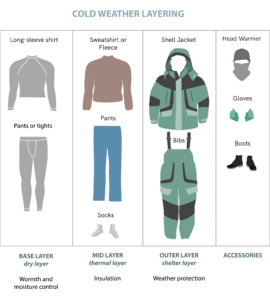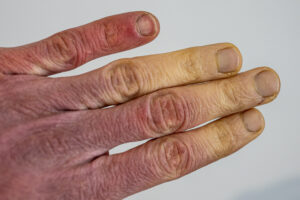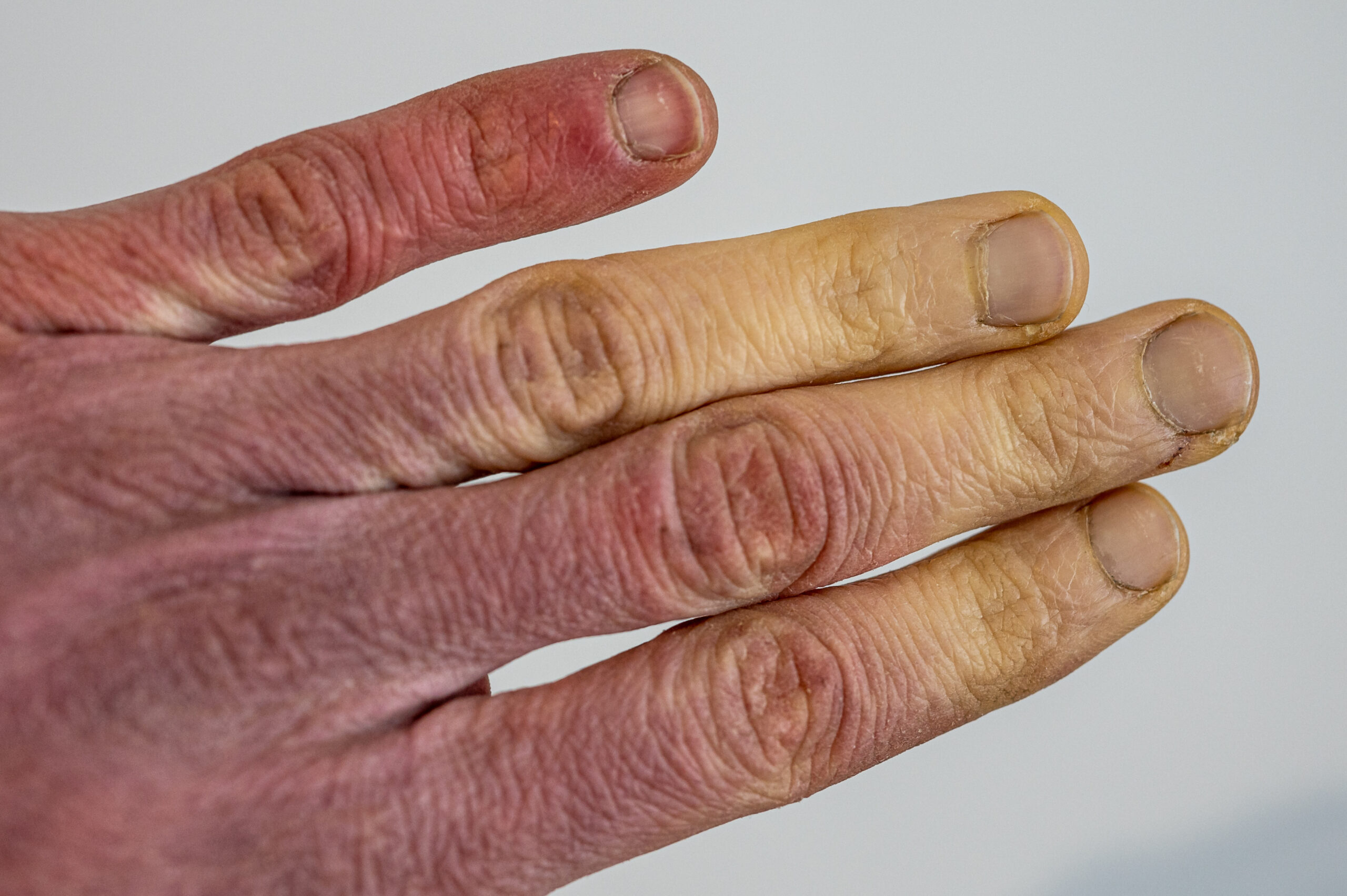Exposure to cold can be an uncomfortable and potentially dangerous situation. It is important to properly prepare, recognize the signs and know how to respond to prevent injuries from occurring.
Hazards that Cause Cold Stress
- Natural or artificially cooled environments.
- Wind, air movement, air temperature.
- Wet clothing from sweat or water.
- Cold water immersion.
- Fatigue, which makes it harder for the body to conduct heat.
Controls to Prevent Cold Stress
Personal Protective Equipment

- Dress in layers
- Base layer keeps you dry, and wicks perspiration from your skin. These garments should “hug” your skin.
- Thermal layer keeps you warm and retains body heat.
- Shell/outer layer shields you from wind, rain and other hazards.
- Ensure that your ears, face, hands, and feet are protected.
Administrative
- Rotate work tasks and personnel.
- Schedule work during the warmest part of the day.
- Know the signs and symptoms of cold stress.
- Adjust pace of work to prevent sweating and standing.
- Staying well hydrated, drinking warm liquids can help maintain a warmer body temperature.
Engineering
- Warm up shelters.
- Wind blocks.
- Equipment and tools designed to be operated with mittens/gloves.
Elimination or Substitution
- Move work location indoors.
- Use equipment instead of manual labour in cold environments.
Types of Cold Stress
Immersion/Trench Foot
Trench foot is a non-freezing injury of the feet caused by prolonged exposure to wet and cold conditions. It can occur in temperatures as high as 15 degrees celsius if feet are constantly wet. Injury occurs because wet feet loose heat faster then dry feet.
- Reddening Skin
- Tingling
- Pain
- Swelling
- Leg Cramps
- Numbness
- Blisters
Immersion/Trench Foot First Aid
- Call 911 immediately in an emergency; otherwise seek medical assistance as soon as possible.
- Remove wet shoes/boots and wet socks.
- Dry the feet and avoid working on them.
- Keep affected feet elevated and avoid walking. Get medical attention.
Frostbite

Frostbite is caused by freezing of the skin tissues. Frostbite can cause permanent damage to the body, and in severe cases can lead to amputation. The risk of frostbite is increased with reduced blood circulation.
- Reddening skin develops grey/white patches in fingers, toes, nose, ear lobes
- Tingling
- Aching or loss of feeling
- Firm/hard blisters may occur in affected area
Frostbite First Aid
- Protect the frostbitten area.
- DO NOT rub the affected area, because rubbing causes damage to the skin and tissue.
- DO NOT apply snow or water.
- DO NOT break blisters.
- DO NOT try to re-warm the frostbitten area before getting medical help.
- Give warm sweetened drinks if alert.
Hypothermia
Hypothermia occurs when the normal body temperature drops below 35 degrees celsius. Cold temperatures cause the body to lose heat faster than it can be produced. Prolonged exposure to cold temperatures will use up the bodies stored energy, resulting in hypothermia.
- Uncontrollable Shivering
- Loss of Coordination
- Confusion
- Slurred Speech
- Heartrate/breathing slow
- Unconsciousness
Hypothermia First Aid
- Call 911 immediately.
- Move the worker to a warm, dry area.
- Remove any wet clothing and replace with dry clothing.
- Wrap the entire body (including the head and neck) in layers of blankets; and with a vapor barrier (e.g. tarp, garbage bag). Do not cover the face.
If medical help is more than 30 minutes away:
- Complete steps above, as well as
- Give warm sweetened drinks if alert, to help increase the body temperature.
- Place warm bottles or hot packs in armpits, sides of chest, and groin.
Do you need more information? RPM can help!
RPM: Trucking Industry Safety offers several courses, online and in-person. Training related to cold stress includes:
- Emergency First Aid & CPR: Level C and AED: This first-aid and cardiopulmonary resuscitation (CPR) course provides the skills needed to recognize and respond to cardiovascular emergencies and choking for Adults, Children and Infants.
- Safety for Supervisors: The objective of this course is to ensure supervisors are provided with information, tools and resources to effectively perform their safety and health roles and responsibilities.
- Hazard Identification and Risk Control: This course will provide students with the practical knowledge necessary to identify, assess and control the hazardous elements of their workplace so they can do their part in preventing dangerous incidents.
Please note RPM courses are offered to RPM registered companies only. Your company must be registered with RPM and be in the process of working towards certification or must have achieved the SAFE Work Manitoba Trucking Certificate of Recognition. Not yet registered in the RPM program? Today is a great day to get started!
Please contact RPM by emailing info@rpmsafety.ca or calling 204-632-6600, or by visiting our website www.rpmsafety.ca.

